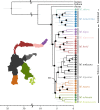Speciation over the edge: gene flow among non-human primate species across a formidable biogeographic barrier
- PMID: 29134059
- PMCID: PMC5666242
- DOI: 10.1098/rsos.170351
Speciation over the edge: gene flow among non-human primate species across a formidable biogeographic barrier
Erratum in
-
Correction to 'Speciation over the edge: gene flow among non-human primate species across a formidable biogeographic barrier'.R Soc Open Sci. 2018 Jun 13;5(6):180736. doi: 10.1098/rsos.180736. eCollection 2018 Jun. R Soc Open Sci. 2018. PMID: 30110472 Free PMC article.
Abstract
Many genera of terrestrial vertebrates diversified exclusively on one or the other side of Wallace's Line, which lies between Borneo and Sulawesi islands in Southeast Asia, and demarcates one of the sharpest biogeographic transition zones in the world. Macaque monkeys are unusual among vertebrate genera in that they are distributed on both sides of Wallace's Line, raising the question of whether dispersal across this barrier was an evolutionary one-off or a more protracted exchange-and if the latter, what were the genomic consequences. To explore the nature of speciation over the edge of this biogeographic divide, we used genomic data to test for evidence of gene flow between macaque species across Wallace's Line after macaques colonized Sulawesi. We recovered evidence of post-colonization gene flow, most prominently on the X chromosome. These results are consistent with the proposal that gene flow is a pervasive component of speciation-even when barriers to gene flow seem almost insurmountable.
Keywords: Wallace’s Line; X chromosome; gene flow; genomics; mechanisms of speciation; primate evolution.
Conflict of interest statement
We have no competing interests.
Figures




Similar articles
-
Mitogenomics of macaques (Macaca) across Wallace's Line in the context of modern human dispersals.J Hum Evol. 2020 Sep;146:102852. doi: 10.1016/j.jhevol.2020.102852. Epub 2020 Aug 8. J Hum Evol. 2020. PMID: 32781349
-
Wallacean and Melanesian Islands Promote Higher Rates of Diversification within the Global Passerine Radiation Corvides.Syst Biol. 2022 Oct 12;71(6):1423-1439. doi: 10.1093/sysbio/syac044. Syst Biol. 2022. PMID: 35703981
-
Paleoenvironments shaped the exchange of terrestrial vertebrates across Wallace's Line.Science. 2023 Jul 7;381(6653):86-92. doi: 10.1126/science.adf7122. Epub 2023 Jul 6. Science. 2023. PMID: 37410831
-
Wallace's line, Wallacea, and associated divides and areas: history of a tortuous tangle of ideas and labels.Biol Rev Camb Philos Soc. 2021 Jun;96(3):922-942. doi: 10.1111/brv.12683. Epub 2021 Jan 27. Biol Rev Camb Philos Soc. 2021. PMID: 33502095 Review.
-
Interpreting the genomic landscape of speciation: a road map for finding barriers to gene flow.J Evol Biol. 2017 Aug;30(8):1450-1477. doi: 10.1111/jeb.13047. J Evol Biol. 2017. PMID: 28786193 Review.
Cited by
-
Mitonuclear interactions and introgression genomics of macaque monkeys (Macaca) highlight the influence of behaviour on genome evolution.Proc Biol Sci. 2021 Oct 13;288(1960):20211756. doi: 10.1098/rspb.2021.1756. Epub 2021 Oct 6. Proc Biol Sci. 2021. PMID: 34610767 Free PMC article.
-
Functional divergence of the pigmentation gene melanocortin-1 receptor (MC1R) in six endemic Macaca species on Sulawesi Island.Sci Rep. 2022 May 9;12(1):7593. doi: 10.1038/s41598-022-11681-z. Sci Rep. 2022. PMID: 35534524 Free PMC article.
-
The landscape of tolerated genetic variation in humans and primates.bioRxiv [Preprint]. 2023 May 2:2023.05.01.538953. doi: 10.1101/2023.05.01.538953. bioRxiv. 2023. Update in: Science. 2023 Jun 2;380(6648):eabn8153. doi: 10.1126/science.abn8197. PMID: 37205491 Free PMC article. Updated. Preprint.
-
Small, odd and old: The mysterious Tarsius pumilus is the most basal Sulawesi tarsier.Biol Lett. 2022 Mar;18(3):20210642. doi: 10.1098/rsbl.2021.0642. Epub 2022 Mar 30. Biol Lett. 2022. PMID: 35350878 Free PMC article.
-
Phylogenomics Reveals High Levels of Incomplete Lineage Sorting at the Ancestral Nodes of the Macaque Radiation.Mol Biol Evol. 2023 Nov 3;40(11):msad229. doi: 10.1093/molbev/msad229. Mol Biol Evol. 2023. PMID: 37823401 Free PMC article.
References
-
- de Queiroz K. 2007. Species concepts and species delimitation. Syst. Biol. 56, 879–886. (doi:10.1080/10635150701701083) - DOI - PubMed
-
- Mayr E. 1963. Animal species and evolution. Cambridge, MA: Harvard University Press.
-
- Dobzhansky T, et al. 1970. Genetics of the evolutionary process, vol. 139. New York, NY: Columbia University Press.
-
- Wallace AR. 1863. On the physical geography of the Malay Archipelago. J. R. Geol. Soc. Lond. 33, 217–234. (doi:10.2307/1798448) - DOI
-
- Mayr E. 1944. Wallace’s Line in the light of recent zoogeographic studies. Q. Rev. Biol. 19, 1–14. (doi:10.1086/394684) - DOI
Associated data
LinkOut - more resources
Full Text Sources
Other Literature Sources

